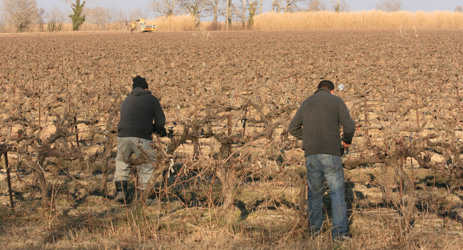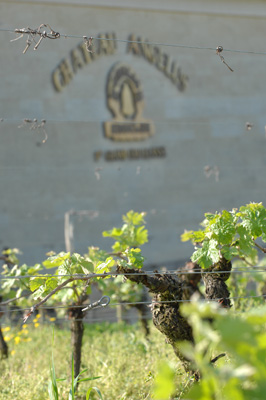‘Pruning is the longest, hardest job of the year,’ says Dider Vallade, chef de culture at Château Angélus in Saint Emilion. ‘It’s cold, it’s tough, it’s solitary. As vineyard manager, one of my most important jobs during the pruning season is to check everyone’s mood as soon as I get in to work, keep their morale up, offer support’.
Pruning is just tailing off in the vines right now, with the bulk of the work carried out between November and February, from the dropping of leaves after last year’s harvest until the rise of sap signalling spring. Many estates have a second round of pruning during the growing season itself, when they cut off excess shoots around the base of the vine that can transfer unripe flavours to the grapes or even green bunches of grapes before they begin to ripen to concentrate the flavours in those that are left behind. But the winter prune is the key crop control and vineyard management task of the year.

and adapted under the Creative Commons BY-SA 3.0 Unported license.
(Please note: the vineyard in the photo was not the vineyard of Château Angélus)
This is the moment when an estate takes control of the vine, when the hand of man starts to exert an influence over what is naturally a wild climbing plant and coaxes it into producing just the right number of grapes to give the desired style and quantity of wine as local customs or individual imaginations require. And, ideally, it has to be done by hand. Vine after vine, row after row, across vineyards that in Bordeaux can spread out over many hundreds of acres. There are pruning machines widely used in the vineyards of California, Italy and Australia – indeed in plenty of regions of France – because their use can reduce costs by up to 80 per cent. But the vast majority of Bordeaux châteaux continue to use teams of pruners, despite a few high profile experiments with robots equipped with four wheels, two arms and six cameras that can prune 600 vines per day.
Tourists and wine lovers invariably prefer visiting wine regions during harvest time, when lush green leaves abound and vines are heavy with promise of the vintage to come. But for anyone hoping to really understand a vineyard, whether to buy it, collect it or simply better enjoy it; this is the time to study the châteaux that most fascinate you. When the vineyard is stripped back to its essentials, its spine exposed, the terroir that châteaux owners talk about during so many wine tastings in cities worldwide is finally laid bare for translation by enquiring eyes. Winter is a keen instructor, freely available to anyone who cares to wander outside.
This ability to read the landscape is why the winter months are when most wineries make strategic decisions about what vines need to be pulled up and replanted, or what plots need to be filled out through replacing missing vines, or by adding cover crops to help balance nutrient levels. It’s the moment for soil to be worked, vine training decisions to be taken and new pickets planted, with wires strung ready to receive the new shoots that will grow in the weeks and months following the pruners’ cuts.

The importance of the work means that unlike harvest, pruning is almost invariably done by key staff members or experienced temporary teams. At Angélus, six permanent workers do all the pruning, followed behind by three women who walk through the rows picking up the discarded wood and vine shoots, just as they would have done in centuries past. This continuity is why, despite the sheer toil, there is a romance and a nobility to the work for anyone looking on from the outside. A vine pruner from 1815 would recognise and understand his 2015 counterpart.
Romance might be less of a draw for the workers themselves, however, and there are sensible moves to nudge this toughest of vineyard tasks into the modern age. At Château Palmer, although most of the pruners are still locals from the Médoc, clear moves have been made to make it a more attractive way of spending the winter months. ‘Good pruning is essential not only for the crop of that particular year but for the ability of the vine to age. We try to keep the same team each year, as it is a skilled job knowing which shoots to discard and which to leave behind,’ says Thomas Duroux, director of the Margaux 3rd growth. ‘And to do that, it seemed essential to make some changes.’
‘When I arrived here in 2004, we were still working with the old system where we paid pruners per vine, and each vineyard block had one male and female worker. Now all pruners are paid by the hour and work together in a team across the whole 135 acre vineyard. When paid by the vine, inevitably people try to go as fast as possible to rack up the numbers, meaning the priority is speed not quality. When paid by the hour there is an immediate increase in quality, with people taking their time to see what the vine actually requires. And by working as a bigger team there is a better sense of camaraderie and the work becomes less isolating. At the same time, a new vine worker is managed by others and learns quickly how we want the pruning to be done. And because we at Palmer farm biodynamically, there are certain days, such as lunar nodes, when we don’t prune, so the team can switch to working on other tasks. Single pruners working alone would not have that flexibility’.
Ask the pruners themselves, and they will say that it’s not just these changes that have made the key difference over the past 20 years. As I drove out of Saint Emilion a few weeks ago, the temperature dropping rapidly below freezing and frost starting to creep across the vines, I saw a group of pruners heading out of a vineyard towards their cars. I pulled over to chat to them, and asked what single improvement had made their jobs easier. They looked at each other and laughed. ‘That’s easy. Electric secateurs. Vine shoots are tough, knarly old beasts, and cutting through them with the old manual secateurs was close on impossible’.

Columnist Introduction
Jane Anson is Bordeaux correspondent for Decanter, and has lived in the region since 2003. She is author of Bordeaux Legends, a history of the First Growth wines (October 2012 Editions de la Martiniere), the Bordeaux and Southwest France author of The Wine Opus and 1000 Great Wines That Won’t Cost A Fortune (both Dorling Kindersley, 2010 and 2011). Anson is contributing writer of the Michelin Green Guide to the Wine Regions of France (March 2010, Michelin Publications), and writes a monthly wine column for the South China Morning Post in Hong Kong, where she lived from 1994 to 1997. Winner of Prix Baron Philippe de Rothschild and graduate of DUAD tasting diploma with Bordeaux Institute of Oenology. Accredited wine teacher at the Bordeaux Ecole du Vin, with a Masters in publishing from University College London.
Click here to read all articles by Jane Anson>>
- Follow us on Weibo @Decanter醇鉴 and Facebook
and Facebook for most recent news and updates -
for most recent news and updates -
All rights reserved by Future plc. No part of this publication may be reproduced, distributed or transmitted in any form or by any means without the prior written permission of Decanter.
Only Official Media Partners (see About us) of DecanterChina.com may republish part of the content from the site without prior permission under strict Terms & Conditions. Contact china@decanter.com to learn about how to become an Official Media Partner of DecanterChina.com.

Comments
Submit